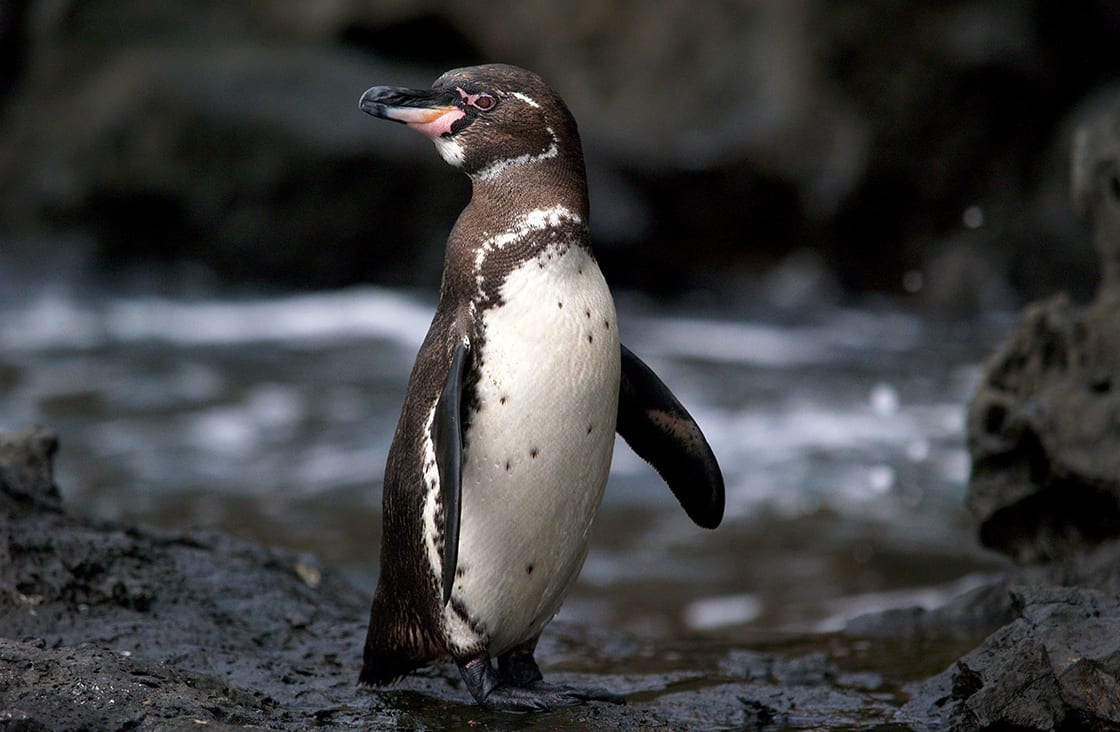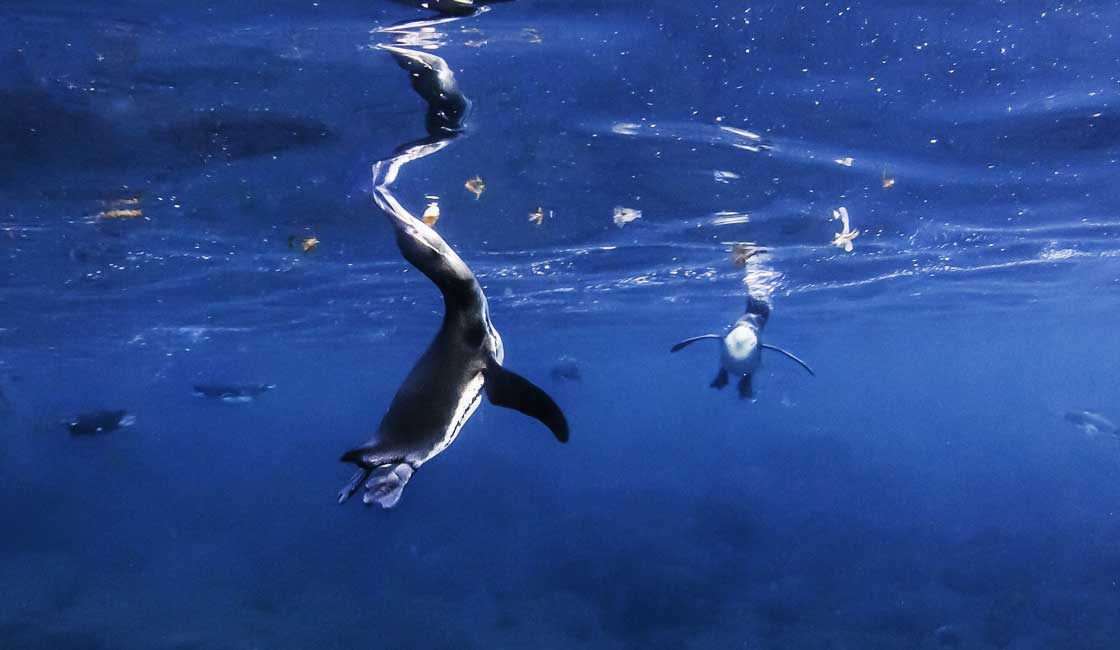
Charismatic and cute, the Galapagos Penguin (spheniscus mendiculus) is undoubtedly one of the most popular creatures on the planet. It is also one of the most unusual. Our rarest penguin, there’s believed to be fewer than 1200 in the world today and their numbers are continually threatened. The image of a penguin in tropical heat is a comical one, but it’s a daily reality for this charmingly idiosyncratic species. Here’s everything you need to know about the Galapagos penguin.
It’s generally accepted that there are about 17 species of penguin, and the Galapagos is the third smallest of them all. They come in at between 40 and 45 cm tall, weighing between 1.6 and 2.5 kg. They are mostly black in color, with white lines and a disproportionately large beak. A characteristic thin white band runs under their chins, and they have a white belly. They look a bit like the Magellanic Penguin, but are even smaller with thinner black markings around the belly.

Penguin On The Rocks
The clue’s in the name. The Galapagos Penguin is endemic to the Galapagos Islands, which is a cluster of volcanic islands that lie either side of the equator, off the coast of Ecuador. Most of this penguin population is found on the western part of the archipelago, with 95% of the population found on Isabela and Fernandina islands, but they can also be found on other islands including Bartholomew, Floreana and Santiago. Bizarrely, they are the only penguin species to be found in the northern hemisphere.
The belief is that long ago, some penguins were swept up and marooned in the Galapagos Islands by a storm or current, all the way from southern Chile. Against all odds, life found a way, and they survived. They have been able to live and breed at this tropical latitude because of the cold water currents that come up that way from the Antarctic, and they have cleverly adapted to make the most of this unusual habitat.

A couple
We all know that penguins are mostly designed for colder climates, and this bespoke biology comes in handy for most of the species… but not for the Galapagos Penguin. However, never ones to complain, this chirpy aquatic flightless bird has developed a few tricks to adapt to the tropical heat of the equator.
The main challenge they faced was keeping cool. They gradually shed a lot of their insulatory fat and became smaller. They use other cooling techniques such as panting and seeking shade. Bare, hairless patches developed on their cheeks – another vital way to release heat. To avoid terrestrial predators, the penguins turn their backs on them – the black color of their behinds blends perfectly with the surrounding rock so they can’t be seen!
In an ingenious feat of never-seen-before evolution, they have developed one almighty skill: they hold their flippers out over their toes to stop their webbed feet from getting sunburnt! There’s nothing more adorable than seeing a Galapagos Penguin on sunburn-watch.

A Catch
They mostly eat small fish like mullet, anchovies or sardines. Although they seem clumsy on land, they are surprisingly nimble when hunting fish, often reaching speeds of up to 15 miles per hour underwater! But no matter how agile, their fishing success is interlinked with some key environmental conditions.
Galapagos Penguins rely on cold water currents such as the Cromwell and Humboldt currents, which bring with them nutrient-rich water and a steady supply of schooling fish. However, during El Niño weather events, surface water warms substantially, and food becomes much more scarce. This food shortage has a direct impact on the population of Galapagos Penguins. Unfortunately, these El Niño events are increasing in frequency due to climate change.

Underwater Hunt
Galapagos Penguins breed all year long, laying two to three small broods of eggs a year, which are then incubated for 35 to 40 days. They mate for life, and both parents incubate the eggs and then feed the young by regurgitating small fish in the nest. Their nests are in rocky crevices or burrows (although they can’t actually dig into the lava rock formations of the islands).
Breeding success is reliant on the constant arrival of cold water from the south. When El Niño events raise the water too much for successful feeding, the penguins stop breeding for a while to ensure the survival of the colony. Less competition for food means more available resources for the existing penguins.

Beautiful creature
Galapagos Penguins are the most endangered species of penguins in the world and are on the IUCN Red List of Threatened Species for birds. They’ve had a series of drastic blows to their numbers in recent history, mostly due to the dramatic El Niño events that bring warm temperatures of currents to the islands.
They aren’t naturally predated in the Galapagos Islands, but in the water, they can be picked off by sharks, fur seals and sealions. Introduced cats, dogs and rats pose a threat – they raid the nests, eating eggs and young penguins, and sometimes bring diseases. Starvation is an issue during times of food scarcity. Another reason for their decline is the lack of nesting sites. Artificial nest sites have been built in an effort to reverse this decline, with much success – they are currently being monitored by environment scientists.
The Galapagos Islands are home to so many intriguing and endearing creatures like the Galapagos Penguin. They played a crucial part in our understanding of how evolution works (thanks to Charles Darwin and his theory of evolution by natural selection) and continue to astound us today. See the Galapagos Penguin for yourself on a Galapagos vacation.
While Rainforest Cruises aim to provide accurate and up-to-date information, we make no representations as to the accuracy or completeness of any information herein or found by following any link on this site. Rainforest Cruises cannot and will not accept responsibility for any omissions or inaccuracies, or for any consequences arising therefrom, including any losses, injuries, or damages resulting from the display or use of this information.




